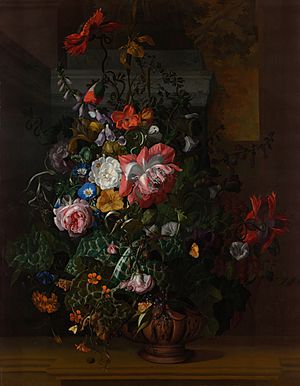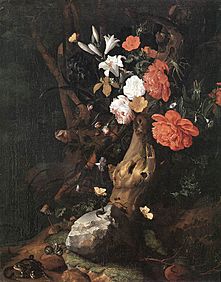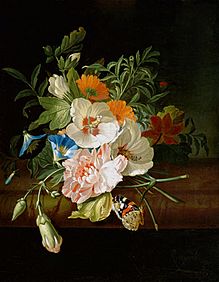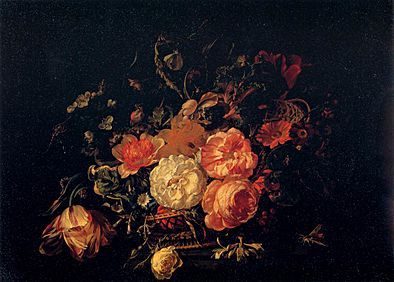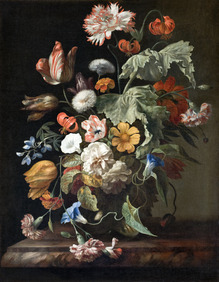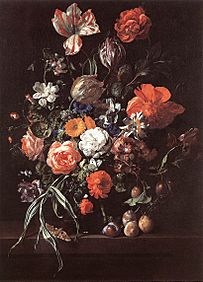Rachel Ruysch facts for kids
Quick facts for kids
Rachel Ruysch
|
|
|---|---|
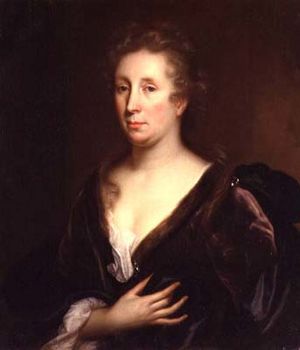
Portrait of Rachel Ruysch by Godfried Schalcken
|
|
| Born | 3 June 1664 The Hague, Netherlands
|
| Died | 12 October 1750 (aged 86) Amsterdam, Netherlands
|
| Nationality | Dutch |
| Known for | Painting |
| Spouse(s) |
Juriaen Pool
(m. 1693; died in 1745) |
Rachel Ruysch (born June 3, 1664 – died October 12, 1750) was a famous Dutch artist. She was known for her amazing still-life paintings, especially of flowers. Rachel created her own unique style and became very famous around the world during her lifetime. She had a long and successful career that lasted over sixty years. Because of this, she is one of the most well-known female painters from the Dutch Golden Age.
Contents
About Rachel's Life and Art Career
Rachel Ruysch was born on June 3, 1664, in The Hague, Netherlands. Her father, Frederik Ruysch, was a scientist. He was a professor of anatomy (studying bodies) and botany (studying plants). He also enjoyed painting as a hobby.
Rachel's father had a huge collection of interesting things. These included animal skeletons, minerals, and plant samples. Rachel used these items to practice her drawing skills. From a young age, she started painting the flowers and insects from her father's collection. She painted them in a style similar to another artist, Otto Marseus van Schrieck. Rachel was very good at showing nature with great detail. As she got better, she even taught her father and her sister, Anna Ruysch, how to paint.
Learning to Paint
In 1679, when Rachel was fifteen, she became a student of Willem van Aelst. He was a very important flower painter in Amsterdam. Rachel studied with van Aelst until he passed away in 1683. He taught her painting techniques. He also showed her how to arrange flowers in a vase. He taught her to make them look natural and not too stiff. This method made her paintings look more real and three-dimensional.
By the time Rachel was eighteen, she was already creating and selling her own signed artworks. She also knew other flower painters like Jan Moninckx, Maria Moninckx, Alida Withoos, and Johanna Helena Herolt-Graff. They were all around her age and worked with plant collectors.
Family Life and Continuing Her Art
In 1693, Rachel married Juriaen Pool, who was a portrait painter in Amsterdam. They had ten children together. Even with a large family, Rachel kept painting and creating art for people all over the world.
During this time, many women were expected to focus on traditional activities like sewing. But Rachel continued her work as a painter. This was likely because her art helped bring money into the family. This allowed them to hire help to care for their children.
Rachel Ruysch passed away in Amsterdam on October 12, 1750. Even after her death, she remained a very respected artist.
Rachel's Famous Artworks
It's not known if Rachel was part of the Amsterdam Guild of Saint Luke. This was a group for artists. However, her early paintings from the 1680s show that she was influenced by Otto Marseus van Schrieck.
By 1699, Rachel and her family moved to The Hague. There, she was asked to join the Confrerie Pictura. She was the first woman to become a member of this art group. In 1701, she and her husband joined The Hague Painter's Guild.
In 1708, Rachel was invited to work for the court in Düsseldorf. She became the court painter for Johann Wilhelm, Elector Palatine. She had a special agreement to paint at home and bring her finished works to Düsseldorf. She continued to work for him and his wife until the prince died in 1716.
Art experts believe Rachel Ruysch was one of the most talented still-life artists of her time. By the time she died at age 86, she had created hundreds of paintings. More than 250 of her works have been officially recorded or are believed to be hers. Her dated paintings show that she painted from age 15 until she was 83. We know this for sure because she often included her age when she signed her artworks.
Rachel's Painting Style
Rachel Ruysch was very skilled at drawing. She also understood older painting techniques. This knowledge helped her become an even better painter. Her art style was part of the rococo movement. It featured playful designs and bright colors.
She paid great attention to every small detail in her work. Each flower petal was painted carefully with delicate brushstrokes. The backgrounds of Rachel's paintings were usually dark. This was a popular style for flower paintings in the late 1600s. Her paintings often had flowers that drooped or wild stems. This made her artworks look full of energy.
In her early work, Rachel painted many "forest floor" pictures. These showed small animals, reptiles, butterflies, and fungi (mushrooms). Later, she focused mainly on painting flowers. She continued this style until her death. This helped carry the 17th-century painting style into the middle of the next century.
Rachel's special skill was observing each flower very closely. She painted them in a super realistic way. She then arranged them into complex designs. These arrangements would be very hard to create in real life. The flowers would not support each other so well. Like most flower paintings from the late 1600s, the colors in her works were very carefully balanced.
Gallery
- Rachel Ruysch's works
-
Rachel Ruysch, Still-Life with Bouquet of Flowers and Plums, 1704, Royal Museums of Fine Arts of Belgium
See also
 In Spanish: Rachel Ruysch para niños
In Spanish: Rachel Ruysch para niños



